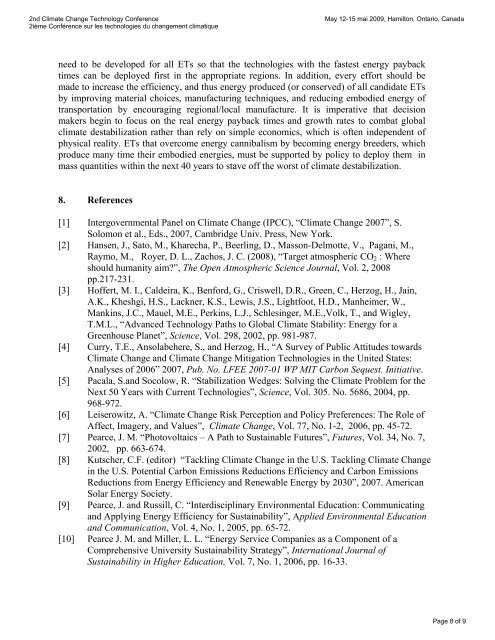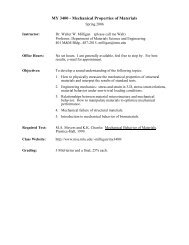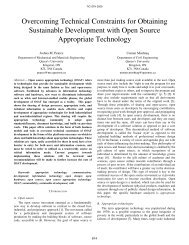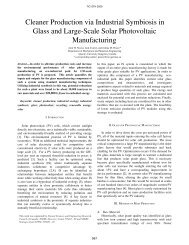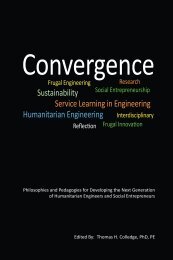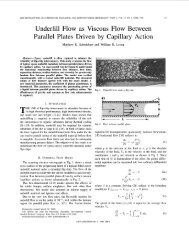Optimizing greenhouse gas mitigation strategies to suppress energy
Optimizing greenhouse gas mitigation strategies to suppress energy
Optimizing greenhouse gas mitigation strategies to suppress energy
Create successful ePaper yourself
Turn your PDF publications into a flip-book with our unique Google optimized e-Paper software.
2nd Climate Change Technology Conference<br />
2ième Conférence sur les technologies du changement climatique<br />
May 12-15 mai 2009, Hamil<strong>to</strong>n, Ontario, Canada<br />
need <strong>to</strong> be developed for all ETs so that the technologies with the fastest <strong>energy</strong> payback<br />
times can be deployed first in the appropriate regions. In addition, every effort should be<br />
made <strong>to</strong> increase the efficiency, and thus <strong>energy</strong> produced (or conserved) of all candidate ETs<br />
by improving material choices, manufacturing techniques, and reducing embodied <strong>energy</strong> of<br />
transportation by encouraging regional/local manufacture. It is imperative that decision<br />
makers begin <strong>to</strong> focus on the real <strong>energy</strong> payback times and growth rates <strong>to</strong> combat global<br />
climate destabilization rather than rely on simple economics, which is often independent of<br />
physical reality. ETs that overcome <strong>energy</strong> cannibalism by becoming <strong>energy</strong> breeders, which<br />
produce many time their embodied energies, must be supported by policy <strong>to</strong> deploy them in<br />
mass quantities within the next 40 years <strong>to</strong> stave off the worst of climate destabilization.<br />
8. References<br />
[1] Intergovernmental Panel on Climate Change (IPCC), “Climate Change 2007”, S.<br />
Solomon et al., Eds., 2007, Cambridge Univ. Press, New York.<br />
[2] Hansen, J., Sa<strong>to</strong>, M., Kharecha, P., Beerling, D., Masson-Delmotte, V., Pagani, M.,<br />
Raymo, M., Royer, D. L., Zachos, J. C. (2008), “Target atmospheric CO 2 : Where<br />
should humanity aim?”, The Open Atmospheric Science Journal, Vol. 2, 2008<br />
pp.217-231.<br />
[3] Hoffert, M. I., Caldeira, K., Benford, G., Criswell, D.R., Green, C., Herzog, H., Jain,<br />
A.K., Kheshgi, H.S., Lackner, K.S., Lewis, J.S., Lightfoot, H.D., Manheimer, W.,<br />
Mankins, J.C., Mauel, M.E., Perkins, L.J., Schlesinger, M.E.,Volk, T., and Wigley,<br />
T.M.L., “Advanced Technology Paths <strong>to</strong> Global Climate Stability: Energy for a<br />
Greenhouse Planet”, Science, Vol. 298, 2002, pp. 981-987.<br />
[4] Curry, T.E., Ansolabehere, S., and Herzog, H., “A Survey of Public Attitudes <strong>to</strong>wards<br />
Climate Change and Climate Change Mitigation Technologies in the United States:<br />
Analyses of 2006” 2007, Pub. No. LFEE 2007-01 WP MIT Carbon Sequest. Initiative.<br />
[5] Pacala, S.and Socolow, R. “Stabilization Wedges: Solving the Climate Problem for the<br />
Next 50 Years with Current Technologies”, Science, Vol. 305. No. 5686, 2004, pp.<br />
968-972.<br />
[6] Leiserowitz, A. “Climate Change Risk Perception and Policy Preferences: The Role of<br />
Affect, Imagery, and Values”, Climate Change, Vol. 77, No. 1-2, 2006, pp. 45-72.<br />
[7] Pearce, J. M. “Pho<strong>to</strong>voltaics – A Path <strong>to</strong> Sustainable Futures”, Futures, Vol. 34, No. 7,<br />
2002, pp. 663-674.<br />
[8] Kutscher, C.F. (edi<strong>to</strong>r) “Tackling Climate Change in the U.S. Tackling Climate Change<br />
in the U.S. Potential Carbon Emissions Reductions Efficiency and Carbon Emissions<br />
Reductions from Energy Efficiency and Renewable Energy by 2030”, 2007. American<br />
Solar Energy Society.<br />
[9] Pearce, J. and Russill, C. “Interdisciplinary Environmental Education: Communicating<br />
and Applying Energy Efficiency for Sustainability”, Applied Environmental Education<br />
and Communication, Vol. 4, No. 1, 2005, pp. 65-72.<br />
[10] Pearce J. M. and Miller, L. L. “Energy Service Companies as a Component of a<br />
Comprehensive University Sustainability Strategy”, International Journal of<br />
Sustainability in Higher Education, Vol. 7, No. 1, 2006, pp. 16-33.<br />
Page 8 of 9


